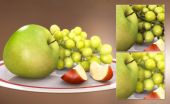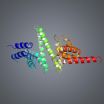(Press-News.org) This news release is available in German.
Overturning cars, flying missiles, and airplanes speeding across the screen -- on modern computers, 3D objects can be calculated in a flash. However, many surfaces still look unnatural. Whether it is skin, stone or wax -- on the computer screen, all materials look alike, as if the objects had all been cut out of the same kind of opaque material. This is about to change: TU Wien (Vienna), the University of Zaragoza and the video game company Activision-Blizzard have developed a new mathematical method which makes surfaces appear much more realistic by taking into account light scattering which occurs below the surface.
The Light from Down Below
When we hold our hand against the sun, it looks red along the edges, because light enters our skin. The appearance of an object is strongly influenced by scattering of light inside the material. "It is called subsurface scattering", says Christian Freude, who works on the new rendering method together with Károly Zsolnai, Thomas Auzinger and Michael Wimmer. "This scattering inside the object is the main reason why different surfaces can look so different. Skin does not look like wax and a plant does not look like a stone surface", says Christian Freude.
Skin is particularly tricky. A face can be rendered in high resolution, with ultra-realistic details, down to single pores and tiny impurities; but this does not mean that it looks realistic. When subsurface scattering is not taken into account, even a perfectly modelled face looks as if it has been chiselled out of a dull, opaque, skin-coloured stone.
It's About Computing Time
"In principle, we could simulate the physics of light scattering below the surface", says Christian Freude. "But to do that, we would have to simulate countless light rays, and it would take hours to render a single picture." Therefore, the research team looked for a method to achieve a similar effect in fractions of a second. This is how the "SSSS-method" (separable subsurface scattering) was developed.
Jorge Jimenez from Activision-Blizzard came up with the basic idea and went on to develop a similar method especially for skin. "Based on that, we have worked out the mathematical basis for displaying arbitrary materials, for example marble, wax or plants", says Professor Michael Wimmer.
"We start by calculating the scattering of a single beam of light below the surface. With this result we can create a simple filter profile, which can then be applied to the images again and again", says Christian Freude. "The computer image is still created with conventional methods, then we modify it with our SSSS-technique, improving the appearance of the surfaces."
"We sought an elegant solution that can be applied to a picture that has already been rendered. The final version of our method only takes half a millisecond per image in full-HD-resolution, on standard commodity hardware", says Károly Zsolnai. This means that the smoothness of the motion is not affected.
"Attempts to include subsurface scattering in real-time rendering have been made before, but up until now, the computing time has always been too long for practical purposes", says Christian Freude. "We have now been able to reduce the modification of a two dimensional image to two one dimensional calculations. This saves computing time but still yields very convincing results."
"This reduction of the dimensionality has been achieved using various mathematical methods, ranging from exact integration and numerical optimization to user-driven color profile modelling", says Thomas Auzinger.
Activision-Blizzard is already using this method. The team is confident that the SSSS-method will soon be used in many other applications too. The new method will be presented in the journal "Computer Graphics Forum", so all developers will be free to use the new approach.
INFORMATION:
Further information:
http://cg.tuwien.ac.at/~zsolnai/gfx/separable-subsurface-scattering-with-activision-blizzard/
Dipl.-Ing. Christian Freude
Institute of Computer Graphics and Algorithms
TU Wien
Favoritenstr. 9-11, 1040 Vienna
T:+43-1-58801-18642
christian.freude@tuwien.ac.at
MSc. Károly Zsolnai
Institute of Computer Graphics and Algorithms
TU Wien
Favoritenstr. 9-11, 1040 Vienna
T:+43-1-58801-18657
karoly.zsolnai@tuwien.ac.at
Our view of what makes us happy has changed markedly since 1938.
That is the conclusion of the psychologist Sandie McHugh from the Univeristy of Bolton who has recreated a famous study of happiness conducted in Bolton in 1938. She will present her study today, Tuesday 5 May 2015, to the Annual Conference of the British Psychological Society in Liverpool.
In 1938 Mass Observation placed an advertisement in the the Bolton Evening News asking readers to answer the question 'What is happiness?'. A total of 226 people sent letters in reply, and they were asked to help compile ...
Ribosomes are vital to the function of all living cells. Using the genetic information from RNA, these large molecular complexes build proteins by linking amino acids together in a specific order. Scientists have known for more than half a century that these cellular machines are themselves made up of about 80 different proteins, called ribosomal proteins, along with several RNA molecules and that these components are added in a particular sequence to construct new ribosomes, but no one has known the mechanism that controls that process.
Now researchers from Caltech and ...
AUSTIN, Texas -- Researchers in the Cockrell School of Engineering at The University of Texas at Austin have developed a centimeter-accurate GPS-based positioning system that could revolutionize geolocation on virtual reality headsets, cellphones and other technologies, making global positioning and orientation far more precise than what is currently available on a mobile device.
The researchers' new system could allow unmanned aerial vehicles to deliver packages to a specific spot on a consumer's back porch, enable collision avoidance technologies on cars and allow virtual ...
SAN DIEGO, Calif. (May 5, 2015)-- Acceptance of premarital sex is at an all-time high along with an acceptance of homosexuality, find researchers led by Jean M. Twenge from San Diego State University.
The researchers -- also including Ryne Sherman from Florida Atlantic University and Brooke E. Wells from Hunter College -- analyzed data from the General Social Survey, a nationally representative survey of more than 33,000 U.S. adults taken between 1972 and 2012. They found substantial generational shifts in attitudes toward non-marital sex and number of sexual partners. ...
Using proteomics techniques to study injured optic nerves, researchers at Boston Children's Hospital have identified previously unrecognized proteins and pathways involved in nerve regeneration. Adding back one of these proteins--the oncogene c-myc--they achieved unprecedented optic nerve regeneration in mice when combined with two other known strategies. The findings were published online April 30 by the journal Neuron.
Researchers have been trying for many decades to get injured nerves in the brain and spinal cord to regenerate. Various molecules have been targeted ...
"Imagine a tiny spotlight like those used in theatres but with a light ray measuring only a few nanometres, which shines light on a given spot but leaves everything else in the dark," explains Monica Mazzolini, SISSA research scientist, "That's how the optic fibres we used in our experiment work". Mazzolini, first author of a paper just published in PNAS, literally shut herself in a "darkroom" lit with infrared light only to stimulate rods, the light-sensitive cells of the retina (for night vision), with these extremely focused light beams in vitro. In their study, Mazzolini ...
ARLINGTON HEIGHTS, Ill. (May 5, 2015) - While it may be a stereotype, it's also true that women seek medical care more frequently than men do. And a recent study shows that women with acute asthma who are treated in the emergency department (ED) are 60 percent more likely than men treated in the ED to need hospitalization.
The study, published in the Annals of Allergy, Asthma and Immunology, the scientific publication of the American College of Allergy, Asthma and Immunology (ACAAI), looked at the sex differences in patient characteristics, and risk of hospitalizations ...
DALLAS, May 4, 2015 -- More bystanders performing CPR contributed to more cardiac arrest survivors returning to work in a Danish study published in the American Heart Association journal Circulation.
In the largest study to date to examine return to work after cardiac arrest, researchers studied 4,354 patients in Denmark who were employed before they suffered out-of-hospital cardiac arrests between 2001 to 2011. Researchers found:
More than 75 percent of survivors who had a cardiac arrest outside a hospital were capable of returning to work.
Chances of returning ...
Many of us take a healthy immune system for granted. But for certain infants with rare, inherited mutations of certain genes, severe infection and death are stark consequences of their impaired immune responses.
Now, researchers at NYU Langone Medical Center have identified an important role for calcium signaling in immune responses to chronic infection resulting from Mycobacterium tuberculosis, the bacterium causing tuberculosis (TB).
Specifically, they determined that the immune systems in genetically altered mice lacking the critically important calcium channel ...
Uninsured people don't have any more difficulty getting appointments with primary care doctors than those with insurance, but they get them at prices that are likely unaffordable to a typical uninsured person, according to new Johns Hopkins Bloomberg School of Public Health-led research.
And payment options are not very flexible, with only one in five people told they could be seen without paying the whole cost up front, suggests the new study published in the May issue of the journal Health Affairs.
"There's a discouragement factor for uninsured people when it comes ...



